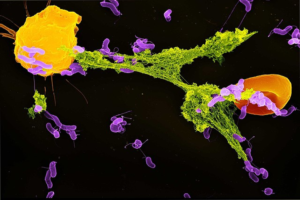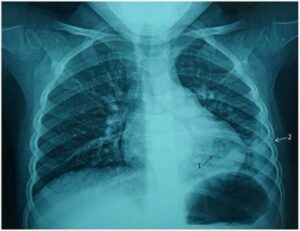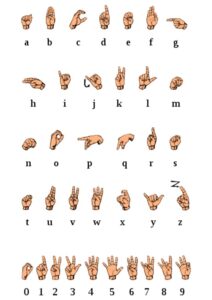
Figure 1: An image of the famous Olsen twins
Source: Wikimedia Commons
Twins are a genetic and developmental phenomenon that have captivated mainstream media and the scientific community alike. Despite their creepy depiction in horror movies, twins are their own individuals . . . usually. A look into twin types must, naturally, include the more common identical and fraternal twins, which are most often looked at in twin studies determining the developmental influence of their genes versus their environment. However, it is equally important to discuss the several rare types of twins that have changed the scientific world’s perception of twinning, fetal development, and the ever-intriguing debate of nature versus nurture in determining traits.
Twin Types
The typical fertilization process occurs between one ovum (egg) and one sperm cell; during ovulation, the female releases one oocyte from the ovary into the fallopian tube, where it is fertilized by one sperm and gives rise to one zygote and ultimately one fetus [Figure 1]. However, this process does not always occur. The birth of fraternal twins, the most common twin type, occurs when two oocytes are released during the same menstrual cycle. The probability of this multiple ovulation event occurring increases with the age of the mother, with parity (number of children already born), with certain genetic factors (for example, women taller than 164 cm have a higher chance of having dizygotic twins than shorter women), with increased follicle recruitment, and, according to some studies, seasonal variation (Chantal Hoekstra et al., 2008). Other factors like nutrition have been directly observed to affect multiple ovulation in animal species but are not currently well established in humans. As these twins arise from two separate ova that are fertilized by two separate sperm, they are genetically similar to ordinary siblings as they share an average of 50% of their DNA (Chantal Hoekstra et al., 2008).
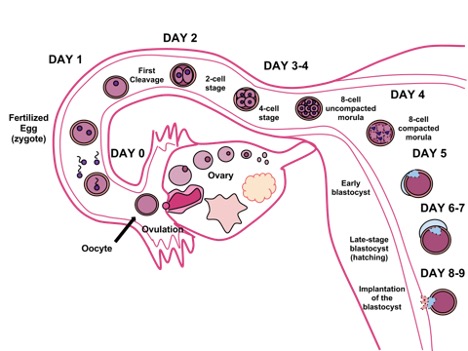
Figure 2: A step-by-step depiction of the human fertilization process, starting with the release of an oocyte and ending with implantation of a blastocyst, an embryo that has begun some cell differentiation and will eventually develop into a fetus.
Source: Wikimedia Commons
In the case of monozygotic twins, commonly referred to as identical, one oocyte is released, but the single zygote splits into two, genetically identical zygotes. Since these twins share the same genetic information, it provides an interesting look into the nature versus nurture argument that perplexes scientists, especially in studies where the twins are raised in separate environments. Despite sharing the same sequence of DNA, identical twins can appear phenotypically different or have different levels of disease susceptibility. These variations could potentially be explained by studying epigenetic variability. The epigenome, a collection of chemical changes to DNA and related proteins that can alter gene expression, dictates control over differences in otherwise genetically identical twins. However, there is some conflicting evidence proposed for this epigenetic theory of phenotypic diversity in identical twins. Some studies indicate a high heritability of epigenetic variation, which is then increased throughout the twins’ lifetimes (Chatterjee, A., & Morison, I. M., 2011). Typical epigenetic changes include DNA methylation, histone modification, and microRNA-mediated regulation, all of which regulate gene expression and are susceptible to environmental factors (Xiang Z et al., 2017). Another study showed that DNA methylation, an epigenetic modification in which a section of DNA is tagged by adding methyl groups to it without changing its sequence, can be highly variable throughout different tissues in the twin pairs. These results suggest the importance of maternal environment and sensitivity during the intrauterine period as factors in forming the epigenome. On the contrary, more recent studies have suggested a low heritability; one revealed patterns in DNA methylation of twins during childhood that became unstable as they aged, suggesting that external environmental factors may assert more influence (Chatterjee, A., & Morison, I. M., 2011).
More rare types of twins can fall under the category of fraternal, identical, or somewhere in between. Conjoined twins, or Siamese twins (such named because of the first reported case being in Siam), are monozygotic (identical) twins whose bodies fuse in utero (Mathew, R. P. et al, 2018). The media has long taken interest in Siamese twins, perhaps because of their rarity; however, the mainstream image of conjoined twins fails to capture all of their unique complexities. Conjoined twins are incredibly rare, accounting for an estimated 1 in 50,000 to 1 in 100,000 births, with the majority being female. They also have low survival rates—approximately 40-60% are stillborn and around 35% of live births die within 24 hours (Mathew, R. P. et al., 2017). Little is known about the risk factors for conjoined twinning; some studies have been done, including a 2010 report that suggested low-dose radiation exposure could increase cases of conjoined twinning, but in each case the number of subjects in the study are too small to reach proper conclusions (Mutchinick, O. M. et al., 2011). Conjoined twins can fuse at various points of the body, and they are classified based on this location: thoracopagus, fused from the upper thorax to the upper abdomen and involving the heart; omphalopagus, fused from the lower thorax to midabdomen; pyopagus, sharing the lower back region; ischiopagus, joined at the pelvis, usually at a 180° angle; craniopagus, sharing the skull but rarely the brain surface; parapagus, sharing the pelvis but laterally (may include separate thoraces, two separate faces, or two separate heads); cephalopagus, joined from the head to the abdomen and exhibiting two faces; and rachipagus, fused along the back, sometimes involving the vertebral column [Figure 2] (Mathew, R. P. et al., 2017).
In some cases, the separation of twins could lead to the death of one and the survival of the other, while not separating could lead to a short life for both, as seen in the Jodie and Mary case (Paris J.J., Elias-Jones A.C., 2001). In this case, two conjoined twins, fused at the abdomen, were separated to save the healthier twin Jodie’s life. Legally, the active ending of life was not allowed, so this decision was made on the base that “treatment” of the more reliant twin would be discontinued by separating the two, as this was legally legitimate. Then, Jodie would be able to live, although disabled. Because of this, the parents did not want to separate. They would have to put up their baby for adoption, as they could not care for her in their hometown, and they preferred that “God’s will” be carried out in the few months the twins would be able to survive together. However, it was decided by law that the surgery occur. It was successful, and Jodie survived (Dyer C., 2002). Developments in technology have made conjoined twins easier to identify and may lead to a better scientific understanding of them in the future. However, there is still a lot of discourse surrounding the separation of conjoined twins. Their separation remains an issue of ethics as much as an issue of medicine and will continue to be explored as more cases appear.

Figure 3: An illustration depicting six of the different conjoined twin possibilities from On Monsters and Marvels by Ambroise Paré. Although our scientific understanding of conjoined twins has advanced significantly since this publication in 1573, the illustrations provide a visual reference for conjoined twins.
Source: Wikimedia Commons
Some rarer cases of conjoined twinning are classified as their own twin type, for instance: heteropagus twins, sometimes also called parasitic twins. In these exceedingly rare cases (estimated to be around four to six cases per 10,000,000), one parasitic twin is not fully formed and entirely reliant on the other, otherwise normal twin (Nega, W. et al., 2016; Dejene, B. et al., 2018). These cases come about much in the same way as other conjoined twins, following similar classifications and “fusion” versus “fission” theories regarding their origin. “Fission” refers to a separation of an embryo that never fully occurs (leading to the parasitic twin) while “fusion” refers to two distinct embryonic “parts” coming together to create the parasitic twin and the autositic twin that can survive independently and nourishes both (Dejene, B. et al., 2018). Again, ethical issues are at play; the parasite is unable to survive without its twin, so it morally ambiguous to claim that the removal of the parasitic twin is fully justified. Additionally, the removal of the twin can be complicated, especially if organs are involved. From an objective point of view, heteropagus twins highlight different theories about embryonic development and the resulting ethical dilemmas that arise if development is incomplete.
Another interesting—and rare—twin type is fetus in fetu. As the name implies, this is an anomaly in which a partial fetus develops inside another fully developed fetus. While originally considered an abdominal mass or a teratoma (a germ cell tumor usually comprised of unrelated tissue types), it was later discovered to contain organs, limbs, and skeleton. While it can cause harm to the developed fetus, it does not have the malignant potential of a teratoma (Smith, Z. and Linthavong, O., 2018). Fetuses in fetu are always monozygotic to their fully developed counterparts, and they are typically surrounded by a membrane similar to an amniotic sac, a sac that helps protect a fetus during pregnancy, but lack a proper placenta and other necessary features such as a circulatory system (Sharma, A. et al., 2012). There are currently less than 200 reported cases of this occurrence, so it is difficult to accumulate information about them and draw conclusions about their formation or medical implications (Smith, Z. and Linthavong, O., 2018). Based on one case study, they are not always fatal to the host twin, but the fetus in fetu is always underdeveloped, malformed due to pressure applied by its host’s organs, and unable to survive on its own [Figure 3] (Sharma, A. et al., 2012).
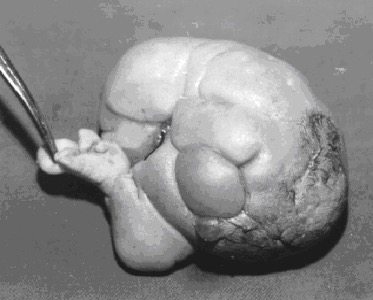
Figure 4: A fetus in fetu after operational removal from its host twin.
Source: Wikimedia Commons
In the case of chimeras, the term “twins” does not even have to refer to two separate people. A chimera refers to an organism that contains cells from multiple zygotes, or one individual that contains multiple genomes. This can happen on an artificial level, such as when an individual receives a bone marrow transplant, consequently displaying a mix of donor DNA and recipient DNA (Rettner, 2016). In a more natural way, pregnant women can become chimeras: studies have shown evidence of fetal cells being present throughout a mother’s body. This likely happens temporarily in most cases, although in some cases fetal tissue is present years or even a lifetime after the mother has given birth (Rettner, 2016). During pregnancy, fetuses are also able to become natural chimeras. Generally, this involves one fetus absorbing another, but it can occur in multiple distinct ways. The first involves the fusion of two separate, fertilized ova, resulting in the total combination of four gametes (tetragametic). The second follows a similar process and also results in a tetragametic chimera, but it involves the separate fertilization of one ovum and the second polar body rather than two ova. The third pathway involves chimeras resulting from the fusion of two separately fertilized daughter cells, which results in a tetragametic chimera as the daughter cells share the same set of chromosomes. Finally, a theoretical possibility would be the fertilization of the first polar body, which would fuse with a fertilized ovum to create a tetragametic chimera (Madan, 2020). Chimeras can be hermaphrodites, an individual possessing both male and female genitalia or sexual characteristics, but most chimeras remain undiscovered. Therefore, the true prevalence of chimeras is uncertain. Furthermore, it could cast doubt on the accuracy of paternity tests and the reliability of DNA for family relations, especially considering cases like the chimeric mother receiving DNA test results that claimed she could not be the mother to two of her three biological sons (Madan, 2020).
If a chimeric ovum undergoes a twinning process, it leads to a new twin type called sesquizygotic twins. The prefix “sesqui-” refers to one and a half, as the resulting sesquizygotic twins are in-between monozygotic and dizygotic twins (Madan, 2020). In essence, they share significantly more than the average 50% of DNA typical of dizygotic twins but significantly less than the 100% of DNA typical of monozygotic twins. In fetu, the twins share the same placenta, a trait typical of monozygotic twins, but, in some cases, were revealed to be different sexes, which is impossible for monozygotic twins. Based on current evidence, another more likely theory for the incidence of sesquizygotic twins is the fertilization of an ovum by two separate sperm, called polyspermy (A New Kind of Twin, 2019). The first reported case of sesquizygotic twins was reported in 2004 when one twin was identified with “ambiguous genitalia.” The twins were found to share approximately 78% of their DNA, being identical maternally but only sharing around half of their paternal DNA. Sesquizygotic twins are considered to be very rare; in a study of 968 dizygotic twins and their parents, none were found to be sesquizygotic (Michael T. Gabbett et al., 2019). This is likely because the survival rate of fetuses containing three sets of chromosomes, the result of polyspermy, are low. In rare cases, it seems the ovum split these three chromosomes into two separate fetuses, both viable and both containing a proportion of their paternal DNA (Michael T. Gabbett et al., 2019). Although the appearances of sesquizygotic twinning makes for interesting case studies, it is not screened for in routine genetic testing nor are these twins used for twin studies due to their rarity.
Twin Studies
While the variety of rare twin types provide insight to the complex process of fetal development, the genetic similarity between monozygotic provides an allows opportunity to study the effects of nature (DNA coding) versus nurture (environment) on a person. The first recorded classical twin study in 1922 focused on heritability of traits, with a focus on eyesight (Sahu, M. & Prasuna, J., 2016). However, it was not until 1990 when the study of the “Jim twins” cemented the idea of a genetic influence on physical and personality traits. These identical twins were raised separately by an adoptive family, so it was assumed that their similarities would be due to genetics. Although some uncanny incidents in their life (such as both having a first wife Betty and a second wife Linda) are generally accredited to coincidence, they showed similarity to twins raised in the same environment in terms of interests, personality, and habits. As with any experiment examining real people outside of a lab, this one had its flaws, but the results can be interpreted to show evidence of a genetic influence on personality (Sahu, M. & Prasuna, J., 2016). Due largely to a wide range of twin studies (containing a rough estimate of 800,000 twin pairs), it is now accepted that human traits are heritable—there are genetic influences on every aspect of behavior (Johnson, W. et al., 2010).
However, it is important to note that DNA is not in full control. One person’s psychology and personality are the result of their genetics and their environment. Heritability estimates, which statistically attempt to predict how much of a trait is due to genetics versus the environment, have wide ranges for each trait; even highly heritable traits are subject to environmental influences (Johnson, W. et al., 2010). Consequently, modern twin studies focus on twins raised together. This design allows for control over their genetics and environment, allowing for the comparison between monozygotic twins to dizygotic twins. The results of this can, in turn, be used to determine the effect of genes against that of the environment (Sahu, M. & Prasuna, J., 2016). Previous studies have found that this relationship is often depicted as the traits of people influencing their environment; however, twin studies have pointed towards the more accurate image of the environment influencing their traits (Johnson, W. et al., 2010). Generally, twin studies have eliminated much statistical variability surrounding studies of genetic versus environmental influence.
Naturally, these sorts of experiments are based on certain assumptions: that of random mating (that people choose partners unlike themselves), that the environments of compared twin pairs are similar, and that genes and the environment make discrete contributions to a trait (Sahu, M. & Prasuna, J., 2016). Because these are imperfect assumptions, the results of these experiments should not be applied as widely as they often are. The studies themselves have a large amount of volunteer bias and may include genetic bias, as some specific genes in mothers may increase the likelihood of twins. Moreover, the studies focus on either the environment or genes without considering their simultaneous effect, although it is well known they both have an influence. This could perhaps be corrected by adding another sibling, raised in the same environment, to the study. Finally, twin studies cannot necessarily be applied to the general population because twins develop differently than any other child due to their shared fetal environment (Sahu, M. & Prasuna, J., 2016). Generally, twin studies have added much information to our view on genetics, the environment, and their collaborative effects on personality; however, like any in vivo study, they come with nuance and controversy.
One of the most prominent controversies surrounding twin studies concerns their considerable background of ethical violations. The popular documentary Three Identical Strangers and its lesser-known predecessor The Twinning Reaction highlight a still-prevalent case in which twin and triplet sets were separated and studied without informed consent. Much grey area surrounds the extent of the study, but it is estimated that at least 11 twin pairs were involved. Furthermore, it is unclear how involved the lead researcher Dr. Peter Neubauer was in the placement and selection of the twins. Some aspects, like the differing socioeconomic status of adoptive families involved and diagnosis of mental illness in biological mothers, seem planned, as if done as part of the study. However, other reports state that the selection process was based on the adoption agency (Glanz, K. and Lynch, H. F., 2019). The ethical violations of this case continue today. Some twin or triplet sets may still be unaware of their participation in this study, and those who have had limited, if any, access to records of the data collected (Glanz, K. and Lynch, H. F., 2019). Neubauer, although now deceased, had donated these records to Yale University but would not allow access to them until 2065. As a result, this case brings up questions regarding how to handle a researcher’s results after their retirement or death and the circumstances under which universities should be able to accept donations of data (Klitzman, R. and Kelmenson, A., 2020). Although this highlights only one specific case, the individuals affected by this case are numerous, and similar ethical violations have likely occurred through the history of twin studies due to their loose guidelines in the past.
Conclusion
Beyond the stereotypical twin characters in horror movies, twins provide insight into the world on a scientific level (and, of course, on a personal one as well). Studies of more rare variations of twins inform the bizarre and delicate process of fetal development. Due to the rarity of many of these types, any new cases would likely provide more insight into such topics as how to improve fetal conditions for healthier children, a deeper understanding of the female body and pregnancy, and the functions of the human body throughout every stage of development. Studies focused more specifically on monozygotic twins show the extent of genetic influences on personality traits. Studying the balance between “nature” and “nurture” may provide more information on factors like those that contribute to disease susceptibility, psychopathic behaviors, or addiction. In the future, more ethical and organized approaches to twin studies could shed light on a variety of questions regarding genes, environmental influence, and development. Twins themselves have fascinated mainstream media, scientists, and the public alike—and the fascination with them unlikely to subside anytime soon.
References
A New Kind of Twin. 2019, March 11. Science in the News. http://sitn.hms.harvard.edu/flash/2019/new-kind-twin/
Chantal Hoekstra, Zhen Zhen Zhao, Cornelius B. Lambalk, Gonneke Willemsen, Nicholas G. Martin, Dorret I. Boomsma, Grant W. Montgomery, Dizygotic twinning, Human Reproduction Update, Volume 14, Issue 1, January/February 2008, Pages 37–47, https://doi.org/10.1093/humupd/dmm036
Chatterjee, A., & Morison, I. M. (2011). Monozygotic twins: genes are not the destiny?. Bioinformation, 7(7), 369–370. https://doi.org/10.6026/97320630007369
Dejene, B., Negash, S. A., Mammo, T. N., Tadesse, A., Getachew, H., & Derbew, M. (2018). Heteropagus (parasitic) twins. Journal of Pediatric Surgery Case Reports, 37, 44–49. https://doi.org/10.1016/j.epsc.2018.07.019
Dyer C. (2000). Siamese twins to be separated against parents’ will. BMJ (Clinical research ed.), 321(7260), 529. https://doi.org/10.1136/bmj.321.7260.529
Glanz, K., & Lynch, H. F. (2019, February 7). Address the ethical violations that led to “Three Identical Strangers.” STAT. https://www.statnews.com/2019/02/07/three-identical-strangers-address-ethical-violations/
Johnson, W., Turkheimer, E., Gottesman, I. I., & Bouchard, T. J., Jr (2010). Beyond Heritability: Twin Studies in Behavioral Research. Current directions in psychological science, 18(4), 217–220. https://doi.org/10.1111/j.1467-8721.2009.01639.x
Klitzman R., Kelmenson A. Experiment on identical siblings separated at birth: ethical implications for researchers, universities, and archives today. Journal of Medical Ethics Published Online First: 04 May 2020. doi: 10.1136/medethics-2019-105983
Madan, K. (2020, September 1). Natural human chimeras: A review. ScienceDirect. https://www.sciencedirect.com/science/article/pii/S1769721220302895
Mathew, R. P., Francis, S., Basti, R. S., Suresh, H. B., Rajarathnam, A., Cunha, P. D., & Rao, S. (2017). Conjoined twins – role of imaging and recent advances. Journal of ultrasonography, 17(71), 259–266. https://doi.org/10.15557/JoU.2017.0038\
Michael T. Gabbett et al. 2019. Molecular Support for Heterogonesis Resulting in Sesquizygotic Twinning. N Engl J Med 380: 842-849; doi: 10.1056/NEJMoa1701313
Mutchinick, O. M., Luna-Muñoz, L., Amar, E., Bakker, M. K., Clementi, M., Cocchi, G., da Graça Dutra, M., Feldkamp, M. L., Landau, D., Leoncini, E., Li, Z., Lowry, B., Marengo, L. K., Martínez-Frías, M. L., Mastroiacovo, P., Métneki, J., Morgan, M., Pierini, A., Rissman, A., Ritvanen, A., … Arteaga-Vázquez, J. (2011). Conjoined twins: a worldwide collaborative epidemiological study of the International Clearinghouse for Birth Defects Surveillance and Research. American journal of medical genetics. Part C, Seminars in medical genetics, 157C(4), 274–287. https://doi.org/10.1002/ajmg.c.30321
Nega, W., Damte, M., Girma, Y., Desta, G., & Hailemariam, M. (2016). Craniopagus parasiticus – a parasitic head protruding from temporal area of cranium: a case report. Journal of medical case reports, 10(1), 340. https://doi.org/10.1186/s13256-016-1023-3
Paris JJ, Elias-Jones AC “Do we murder Mary to save Jodie?” An ethical analysis of the separation of the Manchester conjoined twins Postgraduate Medical Journal 2001;77:593-598.
Rettner, R. L. (2016, August 8). 3 Human Chimeras That Already Exist. Scientific American. https://www.scientificamerican.com/article/3-human-chimeras-that-already-exist/
Sahu, M., & Prasuna, J. G. (2016). Twin Studies: A Unique Epidemiological Tool. Indian journal of community medicine : official publication of Indian Association of Preventive & Social Medicine, 41(3), 177–182. https://doi.org/10.4103/0970-0218.183593
Sharma, A., Goyal, A., & Sharma, S. (2012). Fetus in fetu: A rare case report. Journal of research in medical sciences : the official journal of Isfahan University of Medical Sciences, 17(5), 491–494.
Smith, Zachary and Linthavong, Olivia. Pediatrics May 2018. 142 (1 MeetingAbstract) 232; DOI: https://doi.org/10.1542/peds.142.1_MeetingAbstract.232
Xiang Z, Yang Y, Chang C, Lu Q. 2017. The epigenetic mechanism for discordance of autoimmunity in monozygotic twins. J Autoimmun. 2017 Sep;83:43-50. doi: 10.1016/j.jaut.2017.04.003.
Related Posts
Neutrophils and their NETs
Figure: A neutrophil (yellow) ejecting a NET (green) to capture...
Read MoreCOVID-19 Pneumonia – A Different Illness Than Its Traditional Counterpart
Figure 1: This is an image of a child with...
Read MoreThe Brain and Sign Language — Evidence of a Universal Language Center?
Figure 1: The English alphabet and numbers 1-9 as signed...
Read MoreOlivia Brado

